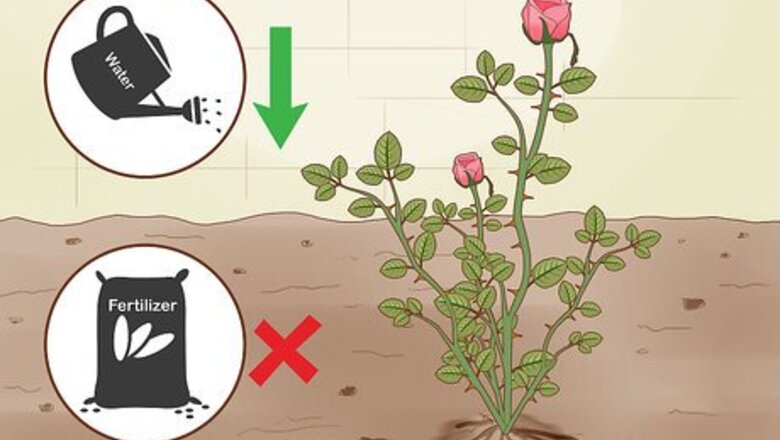
views
Pruning Roses Before Winter
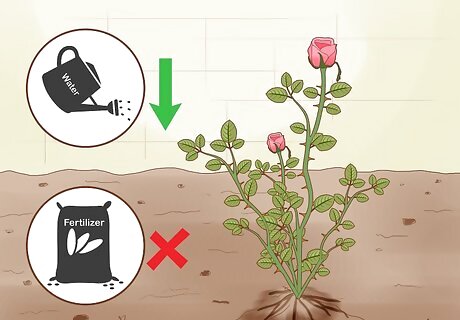
Reduce water and fertilizer 6 weeks before the first frost. This is a popular technique among rose gardeners, known as “hardening off.” Reduce the water by half and stop fertilizing altogether to help prepare your roses for the cold weather. The reduction will help thicken their plant cell walls, giving them a purplish cast. You can look up your first and last frost dates by entering your zipcode at https://davesgarden.com/guides/freeze-frost-dates/#b.
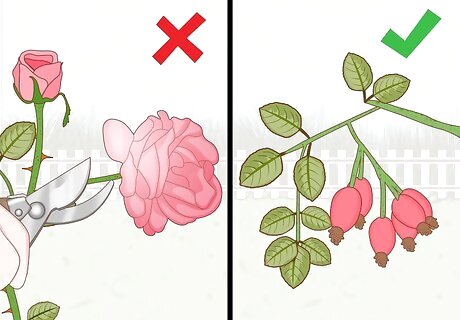
Stop cutting roses in early fall to let hips and seed pods develop. Don’t deadhead or clip any blooms, starting around August, in order to let the plant naturally harden off. Your roses should start developing tough growth-like hips and seed pods, which will help the plant last the winter. In the Southern Hemisphere, early fall occurs in March.
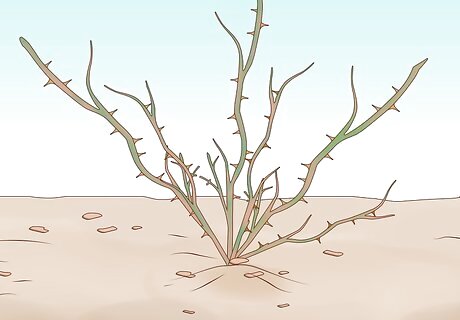
Wait until the roses are dormant before you start pruning. Wait until most or all of the leaves fall and the canes turn a bit off-color. Once the temperature has consistently stayed around 20 °F (−7 °C) for 3-4 days, you can prune and start preparing to winterize your roses.
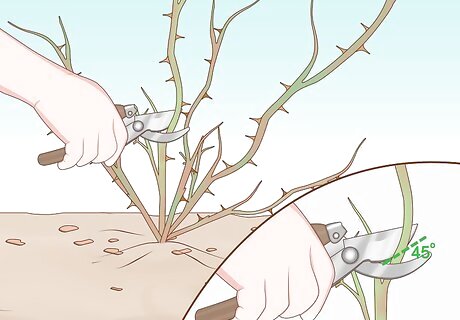
Prune back any long canes to about 5 ft (1.5 m). With your clean, sharp pruning shears, make a cut at a 45° angle. If you can, try to make your cut about 0.25 in (0.64 cm) above an outward-facing bud. Pruning back the canes will prevent them from rocking and breaking in the wind. You should also remove any dead or damaged stems or branches at this point, but be sure not to clip back any other healthy growth. You can cut the rose bushes down as much as 8–12 inches (20–30 cm) above the ground. While optional, trimming them this short may keep your roses looking neat.
Hilling Rose Bushes

Use this technique on hybrid tea roses, grandifloras, and floribundas. These varieties require some extra work and insulation. The hilling technique insulates and covers the rose bush, keeping it frozen and protecting it from the sunlight and wind.

Bring in well-drained soil from outside your garden. You don’t want to scrape up the soil around the plant, since this can damage the root system and decrease the plant’s chances of survival. Instead, buy bagged, well-drained topsoil from a local gardening or home improvement store. “Well-drained” soil simply means it has a good structure, with gaps between the soil particles to allow air and water to flow easily. You can also use compost or straw in place of soil. If you live in a particularly cold area, you may want to add an additional straw cover to your topsoil or mulch.
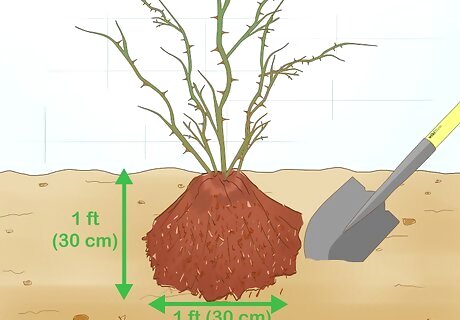
Use a shovel to pile 1 ft (30 cm) of soil around the base of the plant. Fill your shovel with the well-drained soil you brought in earlier and mound it up around the base of the rose bush. Keep adding more soil until you’ve covered the canes with a small mound, about 1 ft (30 cm) high and 1 ft (30 cm) wide. If you use compost for your hilling mound, add another 6 in (15 cm) of compost or straw to the top and sides of the hill.
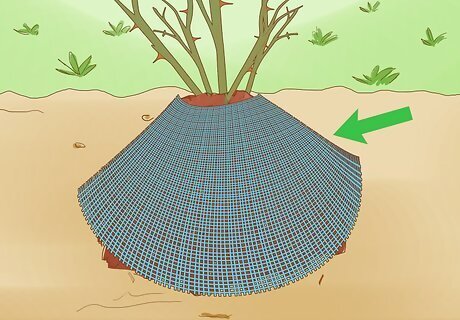
Secure the mound in place if you’re expecting strong wind. To keep your hilling material from blowing away, you can add a layer of gutter screening, chicken wire, a commercial collar, or several layers of newspapers folded in half. This will hold everything in place and ensure proper insulation over the winter. If you don’t secure your hilling materials, you may need to add more throughout the winter to replace what’s blown away.
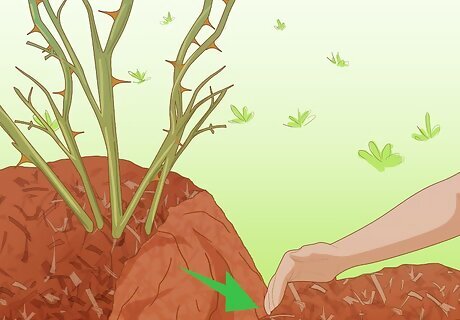
Remove the soil gently in the spring when the ground starts to thaw. Take away the securing layer and slowly pull back the soil, mulch, or straw mound. Spread it around the garden with a rake, like compost. You can find your first thaw date by searching your zip code on https://davesgarden.com/guides/freeze-frost-dates/#b.
Bundling and Wrapping Climbing Roses
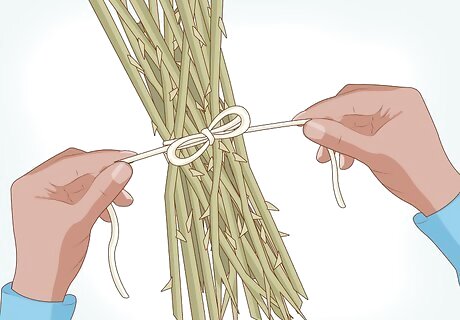
Bundle and tie your climbing roses with zip ties or cotton string. Group together 2-3 canes and gently secure them together for support against the wind. Make sure to keep your zip ties or cotton string loose so they don’t abrade the plant.

Wrap the bundles with dry straw and burlap. Add a layer of dry straw around the canes, then wrap them carefully in a sheet of burlap. Secure the burlap with twine or wire to keep everything in place.
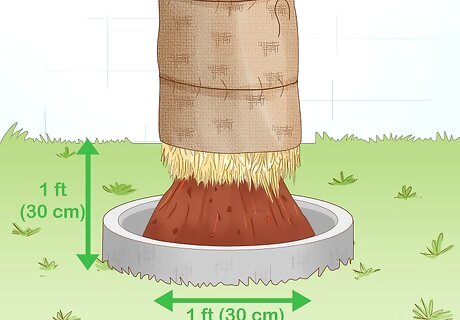
Pile up 1 ft (30 cm) of well-drained soil or compost around the base. Use the hilling technique to protect the plant’s roots and crown. Use a shovel to create a 1 ft (30 cm) high and 1 ft (30 cm) wide mound of soil or compost. If you choose to use compost, add another 6 in (15 cm) of compost or straw to the top and sides of the mound. The level will go down as the compost decomposes.
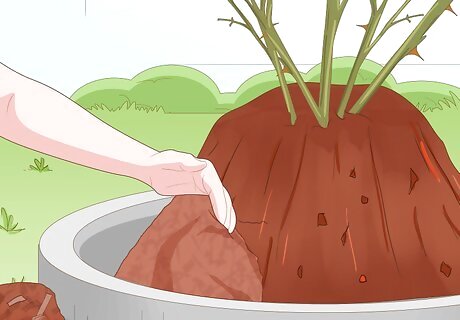
Remove any covering and leaves when the ground thaws in the spring. Carefully pull back the hilling mound, spreading the soil or compost through the garden with a rake. Unwrap the burlap, twine, or wire from the bundled canes gently. Use pruning shears to clip the zip ties or cotton string. You can look up the date of your first thaw by entering your zip code at https://davesgarden.com/guides/freeze-frost-dates/#b.
Winterizing Other Rose Varieties
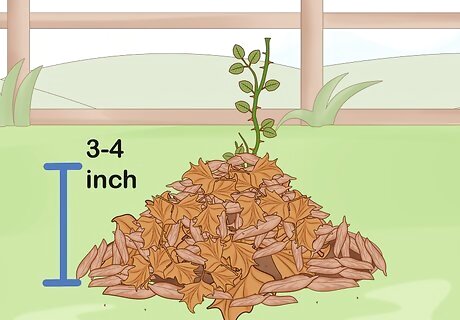
Pile 3 to 4 in (7.6 to 10.2 cm) of dry leaves over mini rose plants. For the smallest variety, which won’t be affected too much by the wind, all you need to do is provide a little protection from potential thawing and refreezing. Once the mini roses are completely dormant, cover the sides and tops with dried leaves. Make sure the leaves are dry, since dampness can lead to disease and mold.
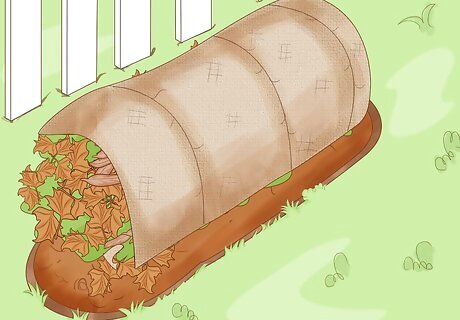
Pile leaves around any shrub roses and secure them with burlap and twine. With taller shrub varieties, stuff leaves and straw around and through the branches. Wrap a length of burlap around the whole bush and tie a length of twine around it to keep everything in place. Some taller shrub varieties include the Ballerina, Bonica, Carefree Beauty, and Knock Out roses. Chicken wire is another option. Use the wire to make a collar or a cage around the roses.

Remove any covering and leaves in the spring when the ground thaws. Gently unwrap coverings or pull out any stuffed-in leaves or straw to end the plants’ dormancy. It’s important to do this at the right time to prevent the roses from thawing and freezing again. Make sure to wait until the ground has thawed, but before the rose puts out new growth. The exact timing depends on the region where you live, but most gardeners de-winterize around early April. In the Southern Hemisphere, it’ll likely be closer to October.
Move any container roses indoors before the first frost hits. In colder climates, you can easily protect your potted roses by bringing them into a garage, shed, or unheated cellar. The temperature indoors should stay between 25 to 40 °F (−4 to 4 °C) during the winter in order for the roses to survive. Once the ground thaws out, you can bring your container roses back outside. If your climate doesn’t get very cold, you can even leave your container roses in a sheltered corner outside, where they’ll be protected from the wind.


















Comments
0 comment